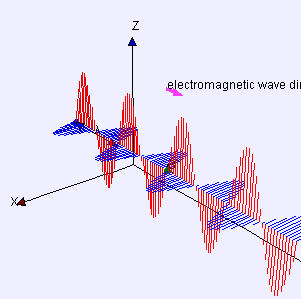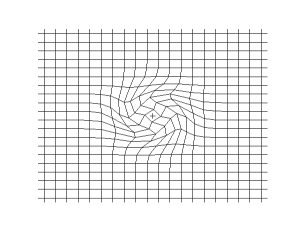
Back موجة عرضية Arabic আড় তরঙ্গ Bengali/Bangla Ona transversal Catalan Příčné vlnění Czech Урлă хум CV Transversalwelle German Εγκάρσια κύματα Greek Transversa ondo Esperanto Onda transversal Spanish Ristlaine Estonian
This article needs additional citations for verification. (May 2019) |



In physics, a transverse wave is a wave that oscillates perpendicularly to the direction of the wave's advance. In contrast, a longitudinal wave travels in the direction of its oscillations. All waves move energy from place to place without transporting the matter in the transmission medium if there is one.[1][2] Electromagnetic waves are transverse without requiring a medium.[3] The designation “transverse” indicates the direction of the wave is perpendicular to the displacement of the particles of the medium through which it passes, or in the case of EM waves, the oscillation is perpendicular to the direction of the wave.[4]
A simple example is given by the waves that can be created on a horizontal length of string by anchoring one end and moving the other end up and down. Another example is the waves that are created on the membrane of a drum. The waves propagate in directions that are parallel to the membrane plane, but each point in the membrane itself gets displaced up and down, perpendicular to that plane. Light is another example of a transverse wave, where the oscillations are the electric and magnetic fields, which point at right angles to the ideal light rays that describe the direction of propagation.
Transverse waves commonly occur in elastic solids due to the shear stress generated; the oscillations in this case are the displacement of the solid particles away from their relaxed position, in directions perpendicular to the propagation of the wave. These displacements correspond to a local shear deformation of the material. Hence a transverse wave of this nature is called a shear wave. Since fluids cannot resist shear forces while at rest, propagation of transverse waves inside the bulk of fluids is not possible.[5] In seismology, shear waves are also called secondary waves or S-waves.
Transverse waves are contrasted with longitudinal waves, where the oscillations occur in the direction of the wave. The standard example of a longitudinal wave is a sound wave or "pressure wave" in gases, liquids, or solids, whose oscillations cause compression and expansion of the material through which the wave is propagating. Pressure waves are called "primary waves", or "P-waves" in geophysics.
Water waves involve both longitudinal and transverse motions.[6]
- ^ "Transverse Waves". L.R. Ingersoll Physics Museum. Retrieved 2024-03-06.
- ^ "Explainer: Understanding waves and wavelengths". 2020-03-05. Retrieved 2024-03-06.
- ^ "Transverse Waves". www.memphis.edu. Retrieved 2024-03-06.
- ^ "Physics Tutorial: The Anatomy of a Wave". www.physicsclassroom.com. Retrieved 2024-03-06.
- ^ "Fluid Mechanics II: Viscosity and Shear stresses" (PDF).
- ^ "Longitudinal and Transverse Wave Motion".
© MMXXIII Rich X Search. We shall prevail. All rights reserved. Rich X Search